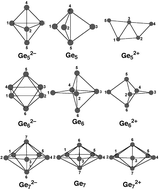A density functional theory study of five-, six- and seven-atom germanium clusters: distortions from ideal bipyramidal deltahedra in hypoelectronic structures
Abstract
Density functional theory (DFT) at the hybrid B3LYP level has been applied to the germanium clusters Genz (n = 5, 6, 7; z = −2, 0, +2) starting from a variety of initial configurations. Double zeta quality LANL2DZ basis functions extended by adding one set of polarization (d) and one set of diffuse (p) functions were used. Bipyramidal global minima were found for Ge52− and Ge72−. These bipyramids were computed to become oblate (i.e., compressed along a major axis) without reduction in symmetry upon loss of two electrons to form the corresponding neutral species. For the six-vertex Ge62−/Ge6 system our computations indicate that the oblate tetragonal bipyramid structure previously found for the 12-skeletal electron In66− undergoes further distortion to give a less symmetrical Cs structure best regarded as an edge-capped trigonal bipyramid. Further removal of electrons from the neutral Gen clusters to give the dications Gen2+ having 2n − 2 skeletal electrons was found to lead to more complicated structural changes. Thus for Ge52+ the lowest energy structure is a completely unsymmetrical (C1) array of three fused triangles whereas for Ge62+ the edge-capped trigonal bipyramid found for Ge6 undergoes further distortion to give a somewhat more symmetrical looking structure best regarded as an edge-bicapped butterfly. Only for the lowest energy computed structure of Ge72+ does the oblate pentagonal bipyramid found for Ge7 remain recognizable although it undergoes further distortion to an unsymmetrical prolate (elongated) bipyramid related to the prolate trigonal antiprisms previously computed for In64− and Tl64−.


 Please wait while we load your content...
Please wait while we load your content...